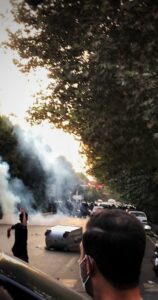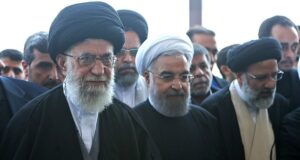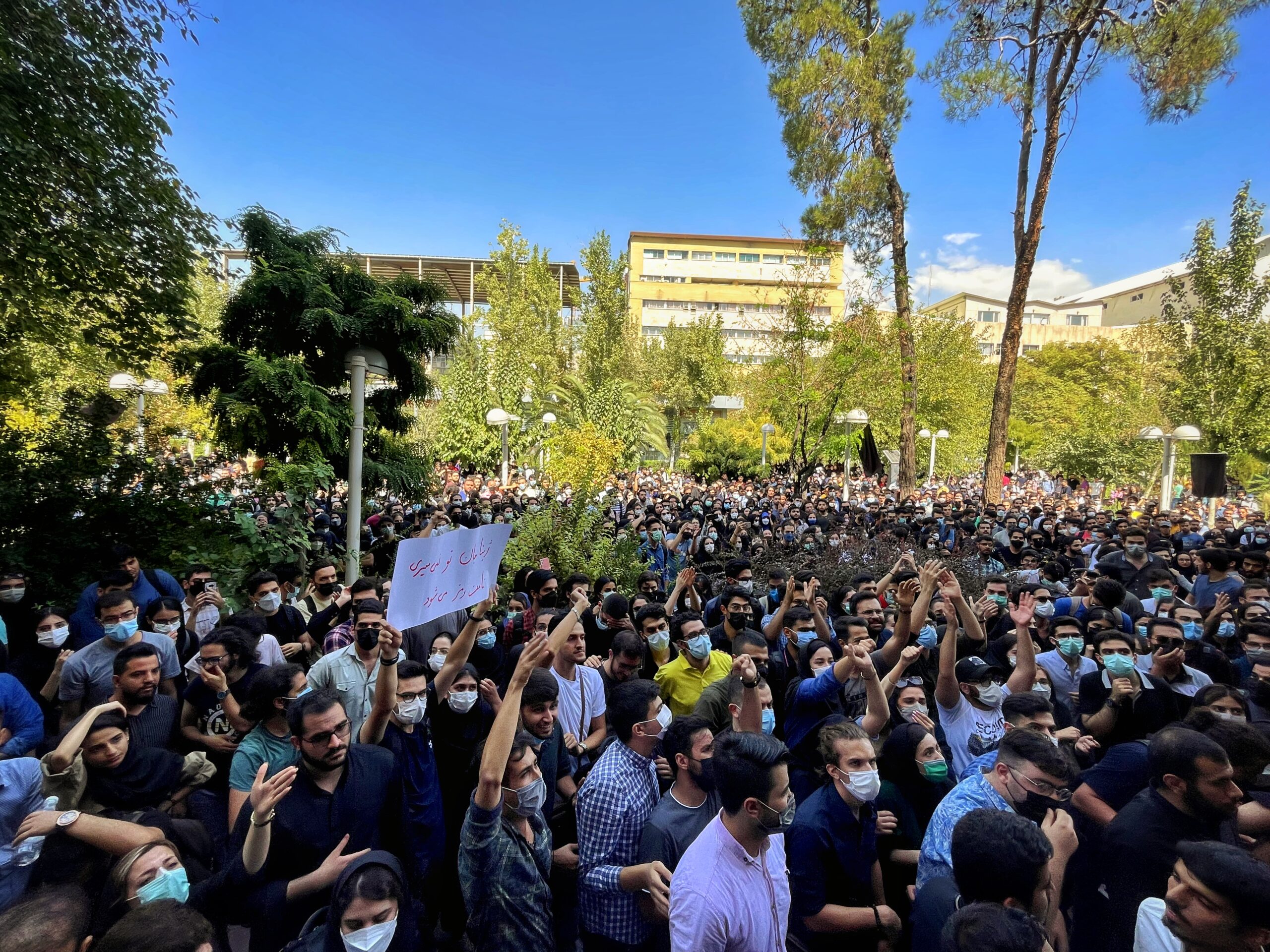People in Iran are protesting. Videos and photos of the protests are circulated around the world. Protesters are chanting „Woman, Life, Freedom„. The protesters oppose the theocratic regime of Iran, and most particularly the dress code mandates – the protests broke out because of a supposedy inappropriately worn head scarf. An overview.
Amini and Khodayari: Misogynistic policy excites protests
The current protests were caused by the death of the 22-years old Kurdish woman Mahsa Amini. On 13th September 2022, Amini visited the Iranian capital Teheran where she was arrested. The accusation: She has allegedly worn her headscarf inaccurately and therefore violated the law. She was brought to a detention centre to be – according to the BBC – „educated“. There she broke down, was brought to a hospital, and deceased after three days in coma.
The consequence: Countrywide protests. In more than 20 universities, teaching staff started to strike. An Iranian male football team wore black jackets while the national anthem was played upfront a match on the 27th November 2022. The jackets covered the national colours and coat of arms on their tricots as a demonstration of solidarity with the protests. Renowned singers, sports stars and other famous persons were arrested for solidarising with the protests.
While the current protests receive much media attention in Western media, they are by no means a surprise to Iranians. The Iranian government has been under societal pressure for much longer. Particularly the lack of women rights have become increasingly the centre of criticism. Protests against the headscarf mandate have been ongoing since 2017, but have intensified after the death of Mahsa Amini.
In 2019, the death of another Iranian woman elicited protests. The 29-years old Sahar Khodayari set herself on fire in front of a court an died from her burns. Before, she had visited a football match, disguised as a man since women were not allowed to enter the stadium, but she was revealed and arrested. She was a fan of the team Esteghal FC, and in relation to the team’s club colours she was soon referred to as the „Blue Girl“ in Social Media. After the Islamic Revolutionary Court declared a six months prison sentence to Khodayari, she committed suicide by self-immolation from which she deceased few days later because of burn injuries.
The country experienced in consequence protests against the misogynistic policy of the Iranian government. Renowned football players solidarised with Khodayari and called on all men to boycot football matches. The International Federation of Football Association (FIFA) also exerted pressure on the Iranian government by threatening to exclude Iran from the football world championship 2022 if not women would be admitted to stadiums as spectators. One month after the death of Khodayari, the Iranian government submitted to the pressure by (partially) lifting the ban on women to attend matches as spectators.
A stronger and united protest movement
The current protests differ from previous protests. Pressure and tensions between civil society and the Iranian government have increased over the recent years. Not only did women protest against the headscarf mandate. The entire political system is questioned – and protesters of all genders are joining forces. Protests are igniting across the country, in every larger city. Intensity of, and support for the protests is larger than ever as they unite people across genders, ethnicities and societal classes. This makes the protests a major threat to the current Iranian system.

Further causes of the currently igniting discontent can be found in recent policy failures of the Iranian government. The Coronavirus-pandemic hit the country hard, leading to protest and criticism against the government’s crisis management. Furthermore, the government’s economic policy along with international economic sanctions on Iran caused losses to the Iranian middle class, with a further deteriorating outlook. The Iranian government has lost the support from the middle class, and while in 2019 it was primarily protesters from the lower classes that went to the streets, it is this time middle and lower class together that are out to protest.
Ethnical minorities in Iran – particularly Arab, Kurdish and Baloch communities – experienced economic marginalisation and discriminatory policies. In the past, they were kept afar by the Persian shia majority. Since the protests after Mahsa Aminis death have broken out in the Kurdish part of Iran, ethnical rifts appear to be closing. Therfore, Iran-expert Ali Fathollah-Nejad (Free University Berlin, Germany) wrote recently in his piece for a German newspaper, it has become impossible to forecast whether the Iranian government could succeed by forcing down the current mass protests with violence as in previous times, or whether the protests may develop into an outright revolution.
A similar situation had been observed in advance to the 1979 Islamic Revolution in Iran. The current protests, and the alienation between government and society, share similarities to the uprising against the disenfranchisement under the Shah.
An end to the Islamic Republic of Iran?
Additional pressure on Iran stems from the Russian aggression against Ukraine and – associated to it – the resurge of the conflict between Armenia and Azerbaijan. Iran’s support for Russia, but also the hegemonial ambitions of Ankara and Baku in the region (including the aim to unite northern and southern Azeri regions to the disadvantage of Iranian authority) exert pressure on Teheran.
Similar to Irak’s aggression against Iran under Saddam Hussein in 1980 (First Gulf War), regional competitors may attempt to seize the opportunity arising from a perceived weakness of Iran. Baku, which attacked Armenia immediately upon a Russian withdrawal from the Caucasus region, could be seen as a wildcard, which could cause unexpected dynamics.
Due to these geopolitical circumstances Iran is constrained in regards to how it can react to its domestic protests, which is strikingly reminiscent of the situation in 1979. Should Iran’s supreme leader Ali Khamenei decease (there have been speculations about deteriorating health conditions), Iran could be at the crossroads – for the better, or the worse. Various scenarios, as recently discussed by American Enterprise Institute (AEI) senior fellow Michael Rubin, represent possible outcomes.

The Islamic Revolutionary Guards Corps (IRGC), though potentially powerful, would at the beginning only control the Iranian capital and centre. In remote regions, and particularly regions where ethnical minorities are dominant, insurrections would certainly ensue. In contrast to the 1979 revolution, however, regional competitors such as Azerbaijan would seize the opportunity to attack. Iran could face a – from the perspective of the IRGC – worse coalition of opponents than it did in the war against Saddam Hussein. Therefore, the (according to Ruben unlikely) scenario that the Islamic Republic would be disbandoned becomes in fact a realistic, or even the most likely scenario. As was noted in the policy brief of our working group in 2021, preconceptions are dangerous guides when analysing likelyhoods of different scenarios.
The geopolitical pressure on Iranian elites, by far and large connected to the outcome of the Russian aggression against Ukraine, will have a strong impact on Iran’s future trajectory. If Moscow has to step back in Ukraine, Baku and Ankara will be encouraged to pursue their strategic aims in the region. This in effect will pressure Iran to as soon as possible form a government that can unify the country behind it. A Ukrainian victory against the Russian invasion army could therefore create an opportunity to save face while disbandoning the Islamic Republic under the urgency to unite the country while external threats are building up.

0 Kommentare zu “The current protests in Iran”